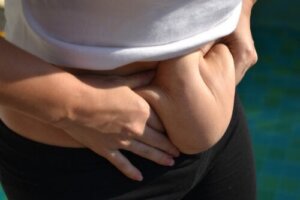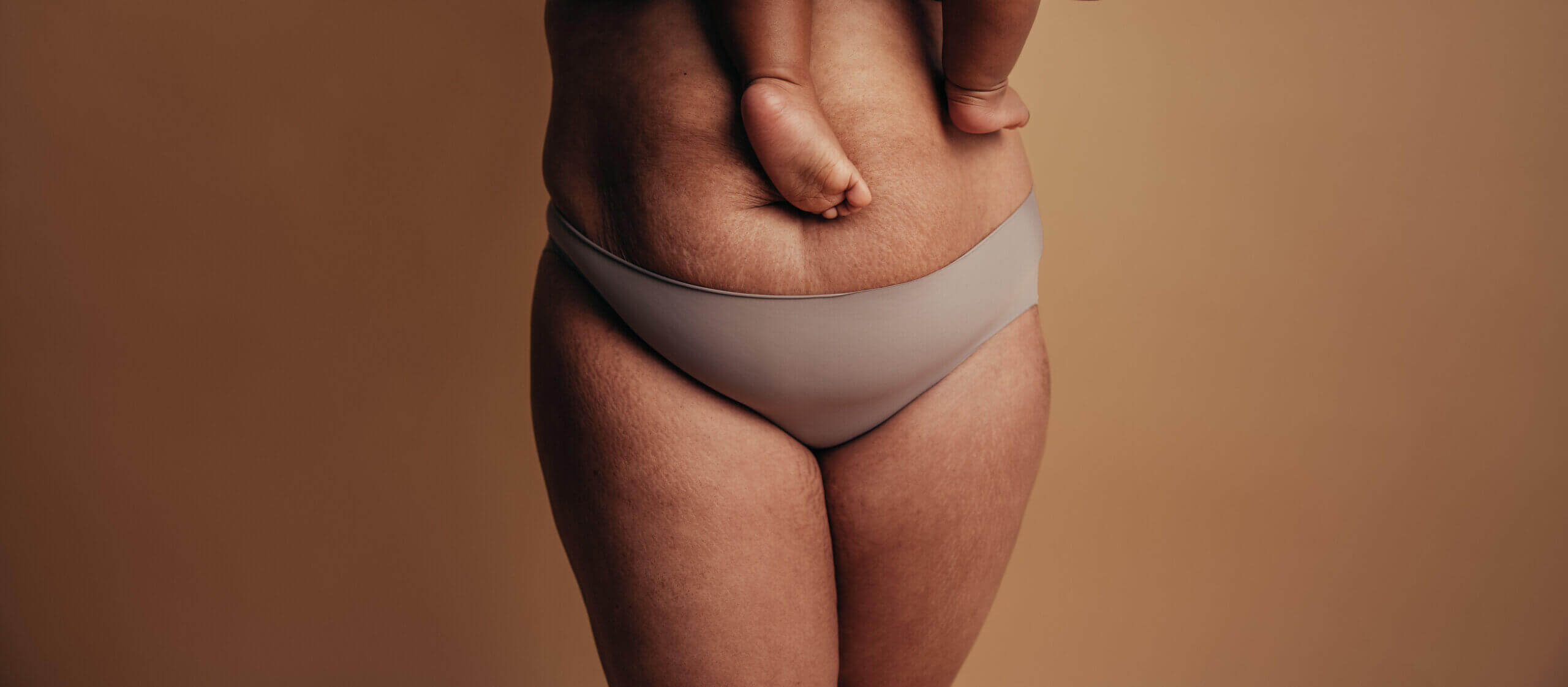How to Reduce a Flabby Belly After Pregnancy?

Reducing a flabby belly after pregnancy is one of the most complex tasks out there. However, don’t let complexity limit you from making it possible.
During the gestation process, the girth of the abdomen increases, on average, more than double its usual size. This is due to the growth of the uterus and the displacement of the visceral organs.
This set of situations causes the muscles and skin to expand greatly. And this combination leads to the famous flabby belly that’s experienced during the postpartum period.
Reduce your flabby tummy after pregnancy
The gestation process is one of the most beautiful experiences a mother can live, as it brings a new life. However, the aftermath of pregnancy isn’t very desirable, right?
Don’t worry, you shouldn’t feel guilty if you want to erase all the changes that pregnancy produced in your body. While it’s a beautiful process, we know that it’s also quite traumatic and that your body is the perfect evidence of it. Especially your belly.
With that in mind, the main objective after pregnancy is to reduce your flabby belly to try to return to your pre-pregnancy measurements. And if possible, even improve them a little more.

What to do to reduce flabby belly?
During pregnancy, the abdomen becomes quite tense, especially after the second trimester. This is due to the excessive pressure caused by the growth of the uterus. However, once the pregnancy is over, the abdominal area loses rigidity and a flaccid belly begins to show.
Although the baby’s no longer inside the body, the abdominal muscles and skin don’t always return to their normal conditions.
At the same time, it takes about 4 weeks for the uterus to regain its normal size. This means that you should go step by step to pursue the goal you have in mind.
Next, we’ll share some recommendations to improve the appearance of your abdomen.
1. Do exercises
The main goal to reduce a saggy belly is to rebuild all the abdominal muscle groups, and for this, you must start exercising consistently.
However, a training professional and your GP should be the ones to indicate how much you exercise during the postpartum period. Usually, it takes about 20 days, minimum, after delivery to start exercising.
Besides executing a properly planned routine, we advise you to resort to various activities to restore abdominal muscle tone. For example, walking, dancing, and swimming. Another recommended option to do exercises and reduce the belly is hypopressive gymnastics.
Always remember that the intensity of the activity must be moderate and that it must be constantly supervised by a suitable professional.
2. Implement a healthy diet
The postpartum period coincides with the beginning of breastfeeding and this period focuses on feeding your baby. Therefore, you must feed yourself in the best possible way.
Even if you want to reduce a flabby belly, you shouldn’t get carried away by any kind of “miracle diet”. These aren’t only unhealthy for your body, but they can also cause nutritional imbalances in your baby.
Healthy diets are those that are made up of fruits, vegetables, protein, compound carbohydrates, and fiber. Try to adopt this habit in your day-to-day routine.
If you have doubts on the subject, ask a nutritionist. This professional can indicate the most appropriate diet for you.
3. Maintain an adequate state of hydration
Aside from the flaccidity caused by muscle breakage and loss of elasticity, fluid retention can interfere with your goal. This retention is due to accumulated toxins, especially in the abdomen and legs.
For this reason, we advise you to maintain adequate hydration levels in order to eliminate toxins through urine and avoid fluid retention in your body. Over time, this practice will help reduce inflammation in the stomach. Check it out for yourself!

Can you use shapewear to reduce a flabby belly?
One of the most common recommendations to reduce a flabby belly after pregnancy is the use of girdles. However, this type of practice isn’t advisable for the health of your body.
It’s undeniable that girdles serve an aesthetic function when worn under clothing. However, they hinder the abdominal muscle recovery process. Also, constant pressure in this area doesn’t help to strengthen these structures at all. It only predisposes you to skin irritation or different infections caused by sweat and heat.
Regarding girdles, we advise you not to use them as an element to reduce flaccidity. They should only be used if the delivery was by cesarean section and your doctor prescribes them.
It’s possible to reduce sagging, just be patient!
The first thing to keep in mind after pregnancy is that your body has done through a lot. So take things calmly, be patient, and above all, put the medical recommendations into practice.
It’s possible to reduce a flabby tummy as long as you don’t take the process lightly. Avoid implementing any “miracle” alternatives that anyone tries to sell you, as they can be very dangerous.
Reducing a flabby belly after pregnancy is one of the most complex tasks out there. However, don’t let complexity limit you from making it possible.
During the gestation process, the girth of the abdomen increases, on average, more than double its usual size. This is due to the growth of the uterus and the displacement of the visceral organs.
This set of situations causes the muscles and skin to expand greatly. And this combination leads to the famous flabby belly that’s experienced during the postpartum period.
Reduce your flabby tummy after pregnancy
The gestation process is one of the most beautiful experiences a mother can live, as it brings a new life. However, the aftermath of pregnancy isn’t very desirable, right?
Don’t worry, you shouldn’t feel guilty if you want to erase all the changes that pregnancy produced in your body. While it’s a beautiful process, we know that it’s also quite traumatic and that your body is the perfect evidence of it. Especially your belly.
With that in mind, the main objective after pregnancy is to reduce your flabby belly to try to return to your pre-pregnancy measurements. And if possible, even improve them a little more.

What to do to reduce flabby belly?
During pregnancy, the abdomen becomes quite tense, especially after the second trimester. This is due to the excessive pressure caused by the growth of the uterus. However, once the pregnancy is over, the abdominal area loses rigidity and a flaccid belly begins to show.
Although the baby’s no longer inside the body, the abdominal muscles and skin don’t always return to their normal conditions.
At the same time, it takes about 4 weeks for the uterus to regain its normal size. This means that you should go step by step to pursue the goal you have in mind.
Next, we’ll share some recommendations to improve the appearance of your abdomen.
1. Do exercises
The main goal to reduce a saggy belly is to rebuild all the abdominal muscle groups, and for this, you must start exercising consistently.
However, a training professional and your GP should be the ones to indicate how much you exercise during the postpartum period. Usually, it takes about 20 days, minimum, after delivery to start exercising.
Besides executing a properly planned routine, we advise you to resort to various activities to restore abdominal muscle tone. For example, walking, dancing, and swimming. Another recommended option to do exercises and reduce the belly is hypopressive gymnastics.
Always remember that the intensity of the activity must be moderate and that it must be constantly supervised by a suitable professional.
2. Implement a healthy diet
The postpartum period coincides with the beginning of breastfeeding and this period focuses on feeding your baby. Therefore, you must feed yourself in the best possible way.
Even if you want to reduce a flabby belly, you shouldn’t get carried away by any kind of “miracle diet”. These aren’t only unhealthy for your body, but they can also cause nutritional imbalances in your baby.
Healthy diets are those that are made up of fruits, vegetables, protein, compound carbohydrates, and fiber. Try to adopt this habit in your day-to-day routine.
If you have doubts on the subject, ask a nutritionist. This professional can indicate the most appropriate diet for you.
3. Maintain an adequate state of hydration
Aside from the flaccidity caused by muscle breakage and loss of elasticity, fluid retention can interfere with your goal. This retention is due to accumulated toxins, especially in the abdomen and legs.
For this reason, we advise you to maintain adequate hydration levels in order to eliminate toxins through urine and avoid fluid retention in your body. Over time, this practice will help reduce inflammation in the stomach. Check it out for yourself!

Can you use shapewear to reduce a flabby belly?
One of the most common recommendations to reduce a flabby belly after pregnancy is the use of girdles. However, this type of practice isn’t advisable for the health of your body.
It’s undeniable that girdles serve an aesthetic function when worn under clothing. However, they hinder the abdominal muscle recovery process. Also, constant pressure in this area doesn’t help to strengthen these structures at all. It only predisposes you to skin irritation or different infections caused by sweat and heat.
Regarding girdles, we advise you not to use them as an element to reduce flaccidity. They should only be used if the delivery was by cesarean section and your doctor prescribes them.
It’s possible to reduce sagging, just be patient!
The first thing to keep in mind after pregnancy is that your body has done through a lot. So take things calmly, be patient, and above all, put the medical recommendations into practice.
It’s possible to reduce a flabby tummy as long as you don’t take the process lightly. Avoid implementing any “miracle” alternatives that anyone tries to sell you, as they can be very dangerous.
All cited sources were thoroughly reviewed by our team to ensure their quality, reliability, currency, and validity. The bibliography of this article was considered reliable and of academic or scientific accuracy.
- Carrillo-Mora, P. Et al. (2021). Revista de la Facultad de Medicina, México. Cambios fisiológicos durante el embarazo normal. http://www.scielo.org.mx/scielo.php?script=sci_arttext&pid=S0026-17422021000100039
- Brahm, P., & Valdés, V. (2017). Beneficios de la lactancia materna y riesgos de no amamantar. Revista Chilena de Pediatria. https://scielo.conicyt.cl/scielo.php?script=sci_arttext&pid=S0370-41062017000100001
This text is provided for informational purposes only and does not replace consultation with a professional. If in doubt, consult your specialist.








